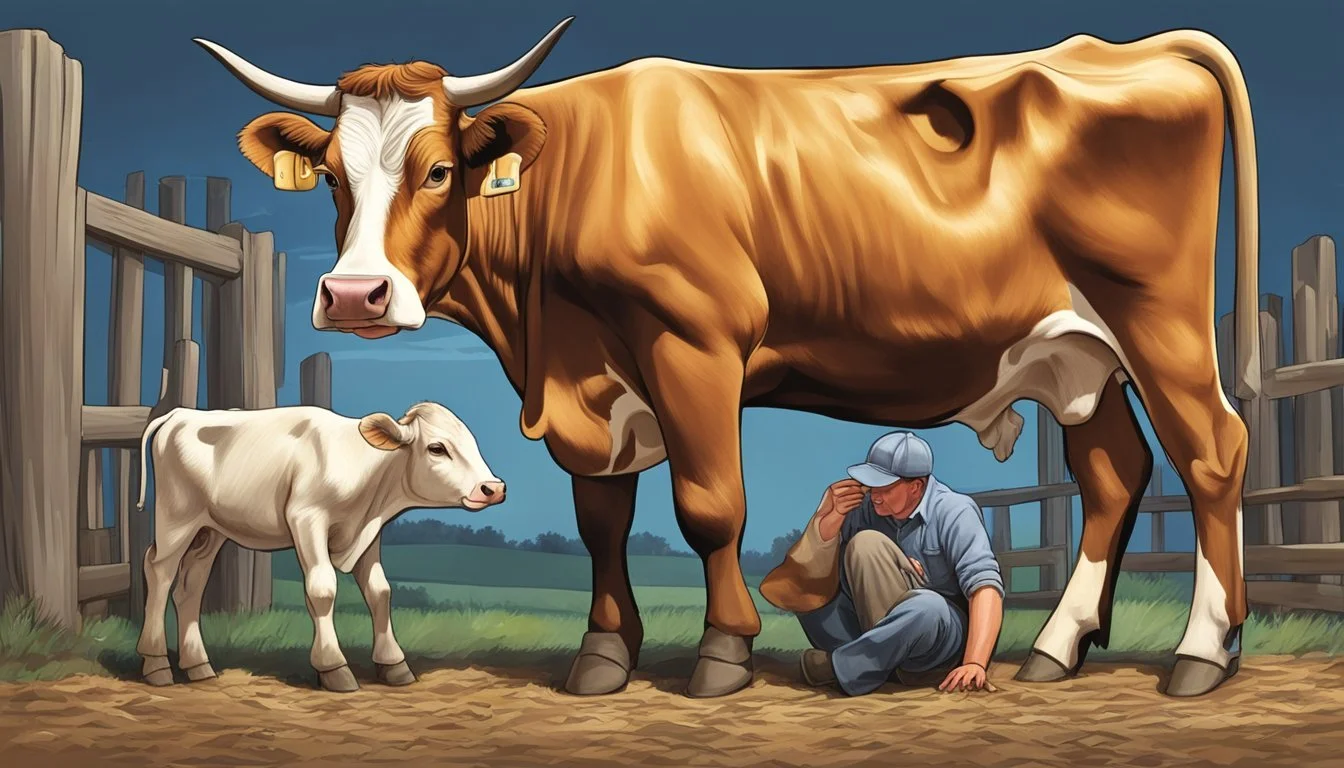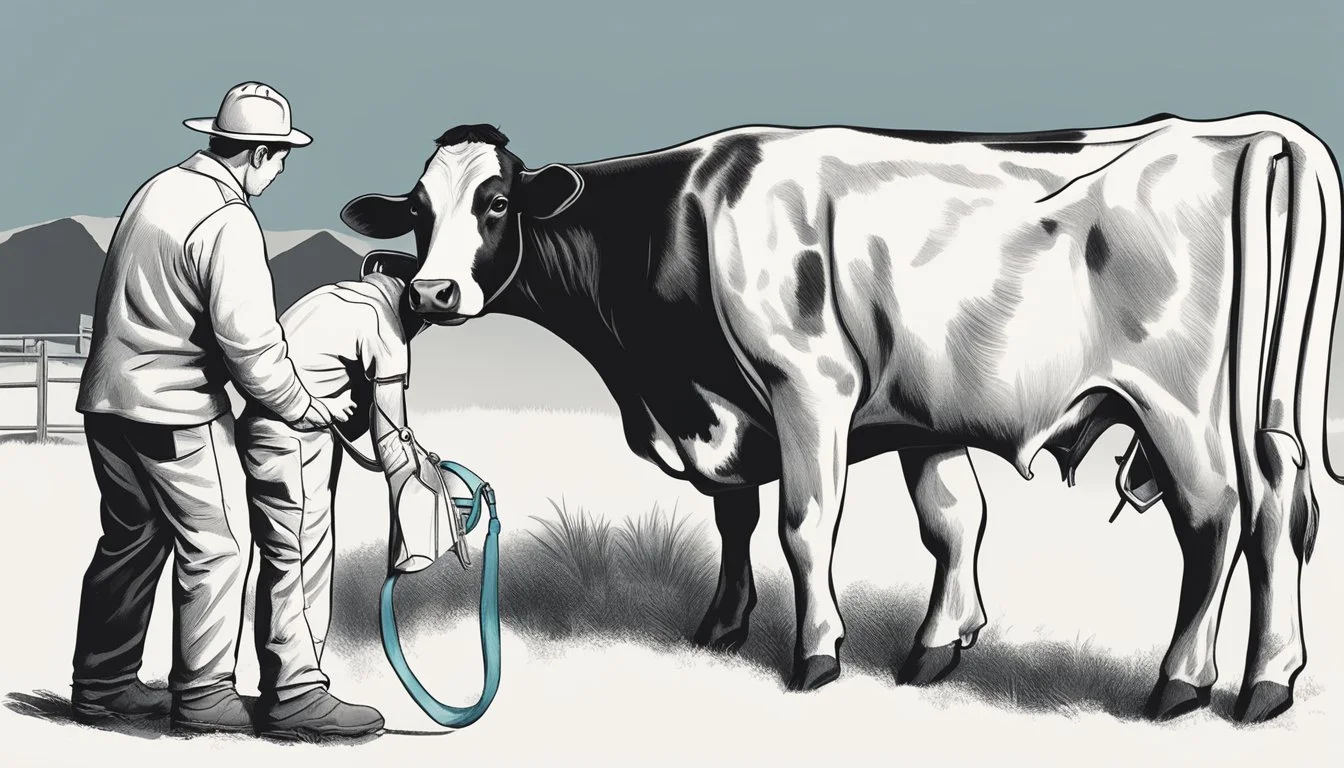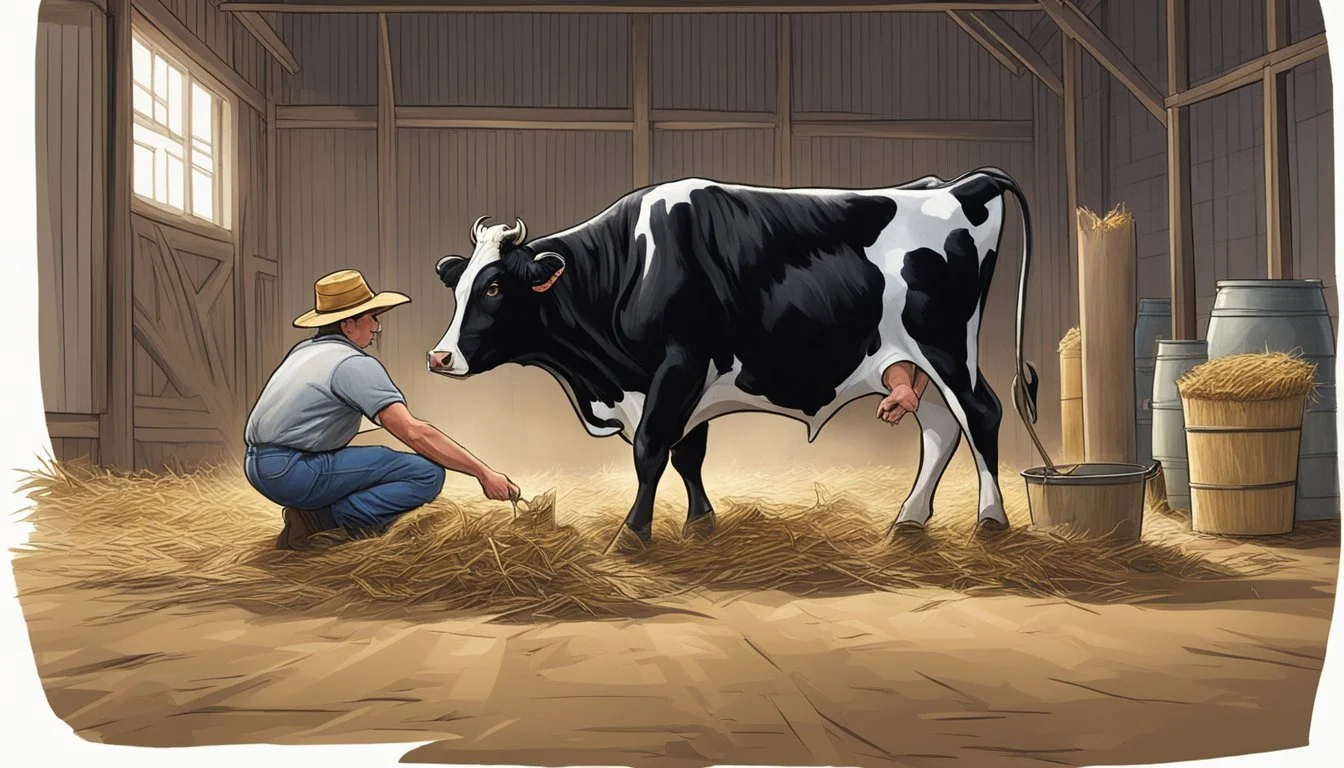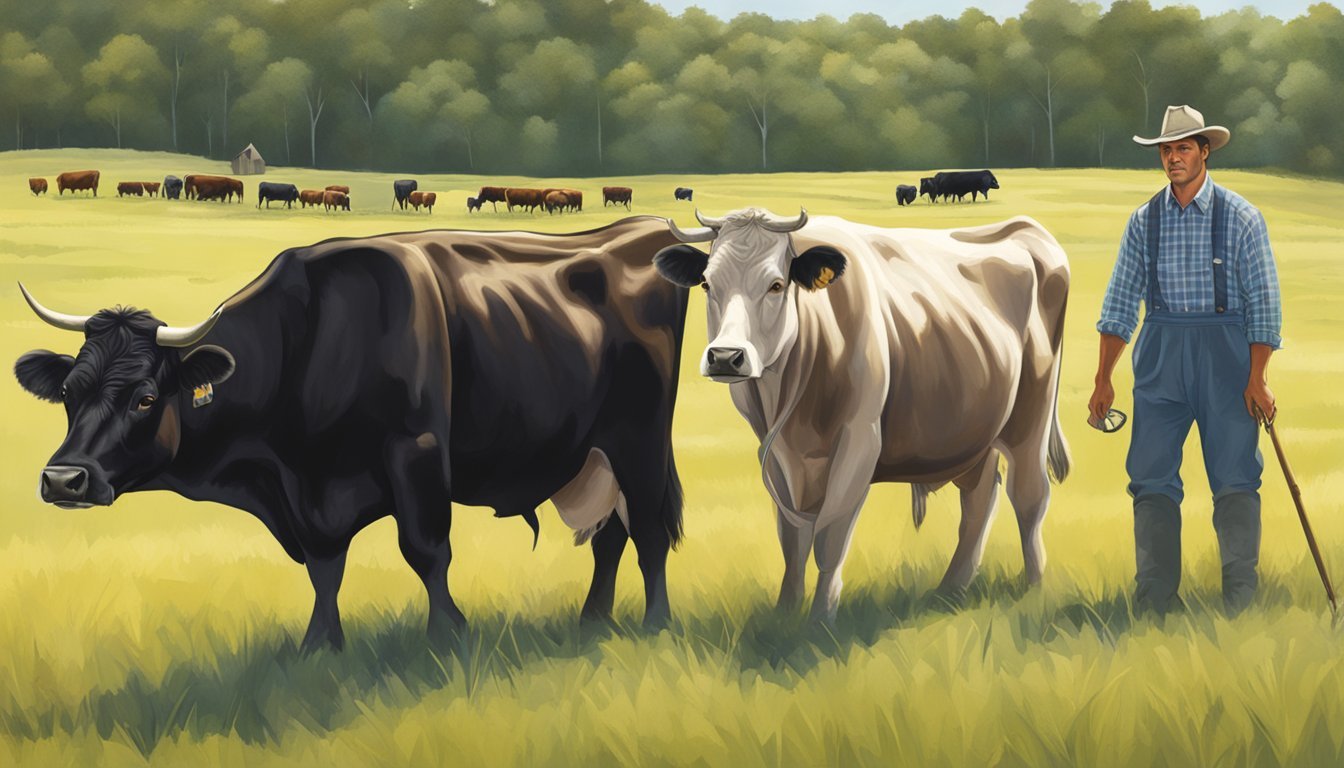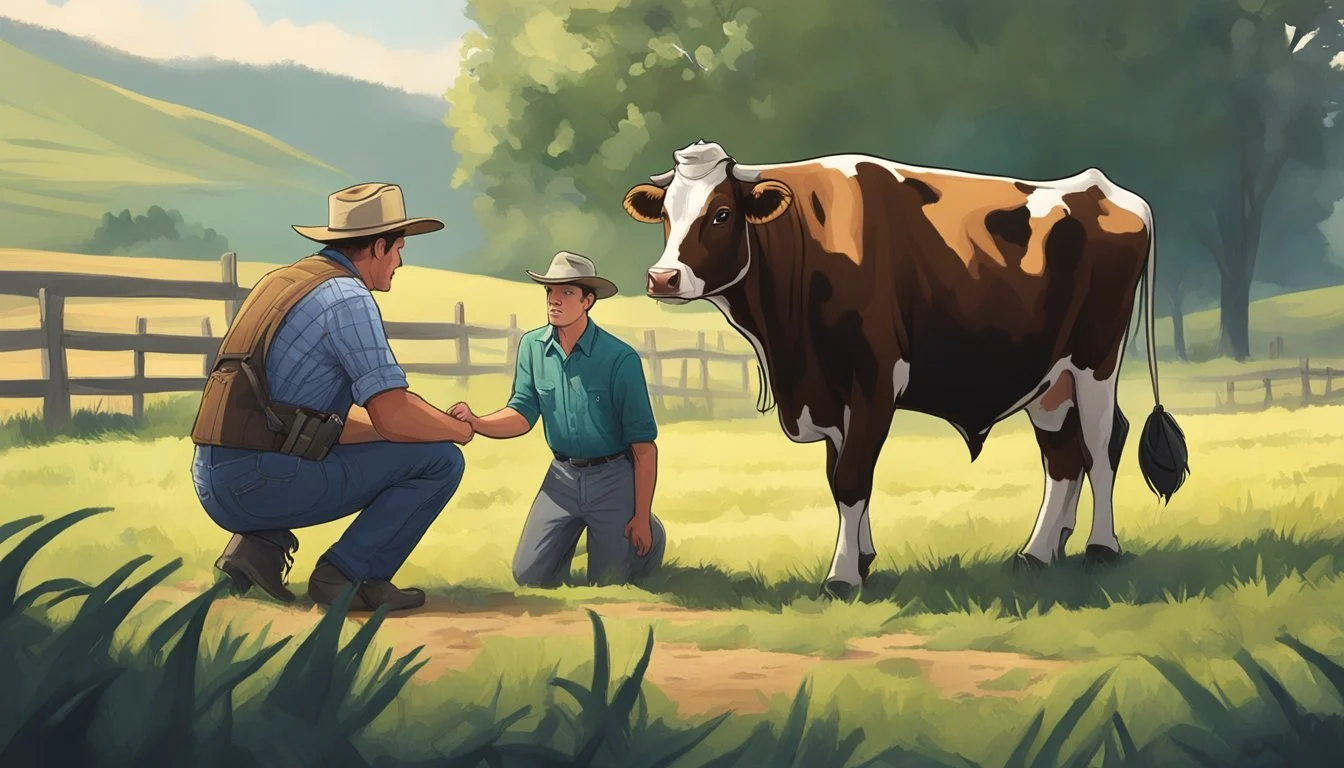How to Handle Calving Emergencies in Dexter Cattle
Essential Steps for Farmers
Calving is a critical period for any cattle operation, and being prepared for emergencies is a paramount aspect of managing a herd of Dexter cattle. Known for their hardiness and compact size, Dexters generally have a good calving record. However, like all breeds, they can experience calving difficulties, or dystocia. The risk of dystocia varies, but is higher in first-calf heifers, estimated at 10-15%, and lower in mature cattle, where it occurs in approximately 3-5% of births. Understanding the signs of a normal calving process and the red flags signaling a potential emergency is crucial for timely intervention, which can be the difference between life and death for both cow and calf.
Successful calving management integrates knowledge of the breed's specific characteristics, like the average 283-day gestation period for Dexter cattle, and general principles of bovine obstetrics. Farmers and ranchers must observe expectant Dexter cows closely as their due date approaches, bearing in mind that calving can occur up to 10 days on either side of the estimated date. This vigilance ensures that they can intervene promptly during calving if the natural process stalls or complications arise.
When facing a calving emergency, the decision to intervene is nuanced. It requires balancing the need to give the cow adequate time to deliver the calf naturally and recognizing when to offer assistance or seek veterinary help. Having a clear plan and the right equipment on hand before the onset of the calving season can facilitate swift action. By situating intervention decisions within a framework informed by both scientific veterinary guidance and practical experience with Dexter cattle, caretakers can improve the outcomes of calving emergencies for this adaptable breed.
Understanding Dexter Cattle
Dexter cattle are a distinctive breed valued for their compact size and versatility. They typically stand at about 36 to 44 inches tall at the shoulder, which classifies them as one of the smallest cattle breeds. Despite their stature, they are strong and well-suited to a variety of climates.
The breed's temperament is generally gentle, making them a suitable option for small farms and those new to cattle handling. Dexter cattle are often chosen for projects that involve children, such as 4-H, because of their manageable size and calm nature.
Color variety is another characteristic of Dexter cattle, as they come in several solid colors. The most common colors include:
Black: The predominant color in the breed.
Red: A rich, deep shade.
Dun: A tan or mousey gray color.
Less commonly, white Dexter cattle are also found, but they are not as prevalent as the other colors.
Dexter cattle are not only valued for their physical attributes but also for their reproductive longevity. Females are known for their prolific breeding capabilities and can continue to produce calves well into their later years.
When considering Dexter cattle for farming, their size and gentle demeanor, coupled with their adaptability to various farming practices, make them a rewarding choice for small-scale operations and sustainable farming initiatives.
Breeding Dexter Cattle
Breeding Dexter cattle requires an understanding of genetics and sound management practices for both bulls and heifers. The gestation period for Dexter cows, typically 283 days, should be monitored closely to ensure healthy calving.
Genetics and Breeding Practices
When it comes to breeding Dexter cattle, genetics play a crucial role in achieving desired traits while maintaining the breed's inherent characteristics. Breeders often select bulls and heifers with specific attributes to produce offspring that are well-conformed, efficient, and exhibit the tri-purpose qualities of the breed (beef, milk, and draft). It's essential to maintain genetic diversity to prevent inbreeding, which can harm fertility and overall health. Regular health screenings and heritable trait analyses enable breeders to make informed decisions.
Key genetic traits to consider:
Body condition: Select animals in prime body condition to increase the chances of successful breeding and healthy offspring.
Fertility traits: Choose bulls known for their fertility to improve conception rates.
Managing Bulls and Heifers
Bulls should be managed carefully to ensure they are fertile and capable of breeding. They should be given a fertility examination before the breeding season to ensure they are able to produce healthy offspring. A well-managed bull can service a modest group of cows, but overuse can lead to injuries for both the bull and the cows. Observing for a 1-7 day longer average gestation period in bull calves compared to heifer calves can inform timeline expectations.
Heifers need to be monitored for readiness to breed, typically around 18-24 months of age. Heifers should be introduced to the breeding bull with consideration for their physical readiness and should be in optimal body condition to carry a pregnancy. Accurate records of breeding dates and expected calving dates are invaluable for managing the reproductive cycle effectively.
Preparing for Calving
In caring for Dexter cattle, diligent preparation is key to managing calving with the aim to ensure the health and safety of both the cow and her offspring. Proper nutritional management and calving facility setup are crucial components for success.
Nutritional Management Prior to Calving
Nutrition: Optimal nutrition is vital for the health of Dexter cows and their calves. Pregnant cows should receive an adequately balanced diet to maintain a desirable body condition score (BCS) which typically ranges from 5 to 7 on a 9-point scale.
Feed: High-quality forage and a tailored mineral supplement can fulfill most nutritional needs. During the last trimester, the cow's nutritional requirements increase significantly to support fetal growth and colostrum production.
Trimester: Last Third
Nutrient Focus: Energy, Protein, Vitamins & Minerals
Feed Examples: High-Quality Hay, Specially Formulated Feed
Monitoring: Frequent assessment of the body condition is critical to adjust feed rations accordingly. Underfed cows may have difficult calving (dystocia), while overfed cows may have excessive fat in the birth canal leading to calving difficulties.
Setting Up Calving Facilities
Shelter: Dexter cattle require a clean, dry, and well-ventilated shelter for calving. This ensures protection from the elements and a comfortable environment for both the mother and newborn calf.
Calving Pen Specifications:
Space: Minimum of 150 square feet to allow ample room for the cow and her handlers during birth.
Bedding: Abundant straw or similar dry bedding to absorb moisture and provide insulation from the cold floor.
Access: The calving area should be easily accessible for monitoring and assistance. It must also facilitate quick intervention if an emergency arises.
Facility Walk-Through: Prior to calving season, farmers should inspect their facilities ensuring all necessary equipment is on hand and functional. The setup should be adaptable for assistance with problematic births.
Calving Process
Calving is a critical time for Dexter cattle, where prompt identification of labor and the successful management of the stages of labor are crucial for the wellbeing of both the calf and the mother.
Recognizing the Signs of Labor
Dexter cattle, like other breeds, exhibit clear signs when labor approaches. These include behavioral changes such as isolation from the herd, restlessness, and a swollen vulva. The cow may also show physical discomfort and start nesting behavior. Observing these signs closely allows the farmer to prepare for the subsequent stages of parturition.
Stages of Labor
Labor in Dexter cattle can be summarized in three main stages:
Stage One: This preparatory phase can last from a few hours to 24 hours. It includes uterine contractions and the dilation of the cervix. The cow may seem uneasy and lie down frequently.
Stage Two: This is the active stage of labor where the calf is delivered. It generally progresses within two hours and can be recognized by the appearance of the amniotic sac, followed by the calf's front hooves and head emerging from the vulva. If a cow does not make progress every 30 minutes, it could indicate an issue requiring intervention.
Stage Three: Post-delivery involves the expulsion of the placenta, typically occurring within 6 to 12 hours. Prolonged retention of the placenta may require veterinary attention.
Post-Parturition Monitoring
After the calf is born, it should exhibit vigor and attempt to stand within 20 to 30 minutes. Monitoring for these signs is important, as immediate standing and nursing are critical for the calf's intake of colostrum. The cow should be observed for any signs of distress or excessive bleeding, and the expulsion of placental material should be confirmed within the expected timeframe.
Handling Calving Emergencies
Calving emergencies can be stressful for both the cattle and the handler. Quick identification and appropriate response are crucial for the well-being of both the Dexter cow and her calf.
Identifying Dystocia
Dystocia, or difficult birth, occurs when the calf is unable to be born naturally without assistance. Signs of dystocia include active labor lasting more than two hours for Dexter cattle, with the cow showing intense straining without progress. Other indicators are abnormal calf positioning, like a breech presentation, and only part of the calf, such as a leg or the tail, being visible.
Intervention and Assistance
When intervention is necessary, cleanliness and gentleness are paramount. Before assisting, one should thoroughly wash their hands and wear gloves to mitigate the risk of infection. Assistance involves guiding the calf through the birth canal, often using calving chains or straps attached to the calf's legs. If there is no progress with gentle traction or if the cow is in obvious distress, further manipulation should be ceased to prevent injury to both the cow and calf.
When to Call the Vet
A veterinarian's expertise is crucial when home interventions fail or if there are signs of severe distress. These include prolonged labor without any sign of a calf, excessive bleeding, or if the cow is in a state of exhaustion. It is essential to have the vet's contact information readily available and not hesitate to call if calving difficulties are suspected or if there is any uncertainty about how to proceed. The veterinarian can perform deliveries that require more advanced intervention, such as a C-section, to protect the health and life of both cow and calf.
Post-Calving Care
Post-calving care is crucial for the welfare and productivity of Dexter cattle. It involves meticulous observation and addressing the immediate needs of the calf and mother to ensure their health and to foster the calf's development.
Calf Health and Colostrum Intake
Colostrum is the first form of milk produced by the mother and it is essential for the calf's immunity. The calf should receive colostrum within the first 2 hours after birth, as its ability to absorb antibodies diminishes rapidly. The goal is to ensure the calf ingests approximately 10% of its body weight in colostrum within the first day. Dexter calves typically require 2 to 4 quarts of colostrum to receive adequate passive transfer of immunity.
Monitoring Mother and Calf
After calving, the cow and her calf should be observed discreetly for bonding and nursing behavior. Heifers and cows may sometimes need encouragement or assistance to allow the calf to nurse properly. Regular monitoring ensures that the mother is recovering from the birthing process and that she is not exhibiting signs of distress or complications such as retained placenta or metritis. The calf should be active and show steady weight gain.
Managing Udder Health
Maintaining udder health involves ensuring that heifers and cows do not develop infections post-calving. Any signs of mastitis require immediate attention. New mothers should be monitored for adequate milk production and symmetry in the udder to identify potential issues early on. Proper management of the udder also includes maintaining clean and dry bedding to prevent environmental contaminants from causing udder infections.
Cattle Health and Welfare
Maintaining the health and welfare of Dexter cattle during the calving season is paramount. Stock owners must provide adequate nutrition to ensure the well-being of both cows and calves. This includes a balanced diet that supports the increased energy demands for milk production, rich in proteins, butterfat, and essential vitamins.
Veterinary care is essential, especially to monitor for calving difficulties or dystocia. Regular check-ups can help prevent injuries and identify any health issues early on. A vet should be consulted promptly if a calving emergency arises to safeguard the health of the cow and calf.
The quality of meat and milk is directly related to animal welfare. Cattle subjected to stress or poor health care provide lower quality beef and dairy products. Hence, ethical and humane handling techniques are not only a moral responsibility but also impact the end product.
Component: Nutrition
Importance for Dexter Cattle during Calving: For strong immunity and energy for calving
Component: Veterinary Care
Importance for Dexter Cattle during Calving: For management of emergencies and overall herd health
Component: Humane Handling
Importance for Dexter Cattle during Calving: To minimize stress and potential injuries
For dairy Dexters, the focus should also include monitoring the milk for signs of mastitis or changes in milk composition, as these can indicate health issues.
Cattle owners should adopt a proactive strategy, including preventative measures such as providing clean, dry, and safe calving environments. This helps to reduce the incidence of calving injuries and ensures that both beef and dairy products are of the highest quality, reflecting good herd management practices.
Farm and Ranch Management
Effective management of Dexter cattle during calving season requires diligent planning involving adequate shelter, nutrition, and record-keeping. These preparations ensure the health and safety of both the cow and calf, which is essential for the successful production of dairy products and meat.
Housing and Shelter Requirements
Dexter cattle require sturdy, weather-resistant housing to protect them from extreme climate conditions.
Shelter: A well-ventilated barn or shed is crucial, with a clean, dry area designated for calving.
Space: Each cow should have enough room to lie down, stand up, and turn around without restriction.
Farmers and ranchers must regularly inspect housing structures to prevent injury to the animals and ensure their comfort.
Pasture and Feed Management
High-quality feed and well-managed pastures are essential for the health of Dexter cattle, especially during calving.
Pasture: They should have access to ample pasture land to graze, with rotational grazing practices to maintain grass quality.
Feed: A balanced diet of grass, legumes, and supplemental feed ensures proper nutrition, particularly for pregnant and nursing cows.
This proper management of feed and pasture is essential to support the cow through the calving process and to nurture the growth and development of the calf.
Breeding Records and Performance
Accurate and detailed breeding records are a fundamental aspect of farm and ranch management, aiding in improving herd genetics and performance.
Breeding Records: Include details such as sire information, expected calving dates, and calving ease scores.
Performance: Monitor and record cow and calf health postpartum, growth rates, and any complications or interventions required during calving.
These records help farmers make informed decisions about future breeding matches, potential sales, and management practices to enhance the overall success of the ranch.
Benefits of Dexter Cattle
Dexter cattle, recognized for their compact size and hardiness, bring significant advantages to small-scale farming operations. These benefits are particularly evident in their adaptability to diverse climates and contributions to homesteads and small farms.
Adaptability to Various Climates
Dexter cattle are exceptionally hardy, capable of thriving in a wide range of climates. Their robust nature allows them to withstand harsh weather conditions, making them suitable for various environments. This adaptability reduces the need for expensive sheltering or feeding regimes, as they can often prosper on pasture-based diets, which can be complemented with grain when needed.
Tolerance: High adaptability to both hot and cold climates.
Diet: Thrive on pasture-based diets with optional grain supplementation.
Contribution to Homesteads and Small Farms
On small farms and homesteads, Dexters serve as an ideal family cow due to their manageable size and efficient space requirements. They make a significant contribution by providing a higher meat yield proportion compared to many other breeds, despite their smaller stature. Their gentle nature and reduced space needs make Dexters a practical choice for those with limited acreage who wish to embrace self-sufficient farming practices.
Size: Smaller and more manageable than larger cattle breeds.
Meat Yield: Higher percentage of usable meat, up to 60% from grain-finished and 55% from grass-finished steers.
Space Efficiency: Ideal for operations with limited land area.
Raising: Suitable for family-focused homesteading due to their manageable size and temperament.
Dexter Cattle in Agriculture
Dexter cattle serve multiple worthwhile purposes in agriculture, being valued for their milk and meat production as well as their capacity to work as draft animals. These compact and hardy animals adapt well to various climates and are a practical choice for small-scale operations.
Dexter Cattle for Milk Production
Dexter cattle are recognized for the quality of their milk, which is higher in butterfat and protein than many other breeds, making it ideal for dairy products including cheese and butter. Their milk yield, while lower in volume than larger dairy breeds, is rich and nutritious, catering to niche dairy markets and homestead farmers focused on self-sufficiency.
Dexter Cattle for Meat Production
When it comes to meat production, Dexters provide a high-quality meat with excellent flavor and tenderness. Their smaller stature translates to a more manageable meat quantity for families or direct-to-consumer models, avoiding the excess often associated with larger breeds. The meat's quality, alongside the breed's ability to thrive on both pasture-based diets and grain supplementation, positions Dexter cattle as a sustainable meat source.
Utilizing Dexters as Draft Animals
Though less common today, Dexter cattle have historically been used as draft animals. Their strength and size allow them to be effective in this role, particularly on smaller farms where using larger draft animals might not be feasible. Their versatility extends to tasks such as pulling carts and plowing fields, providing an additional benefit for agricultural operations seeking to minimize their reliance on machinery.
Cultural and Historical Importance
The Dexter cattle breed possesses a rich history and cultural significance, particularly within its Irish origins and development within American breeding contexts, which has led to a resurgence in interest as a versatile and heritage breed.
Origins and History of Dexter Cattle
Dexter cattle hail from Ireland, where they emerged in the 18th century. Their name is derived from Mr. Dexter, an agent of Lord Hawarden, who played a significant role in the breed's development. Ireland remains the Dexter's historic source, where these compact, hardy cattle adapted to the rugged southern and southwestern landscapes.
American Dexter Cattle Association
In the United States, the American Dexter Cattle Association (ADCA) serves as a pivotal institution for breeders. Reestablished in 1940, the ADCA has played a crucial part in maintaining the breed's standards and records since its name change from the American Kerry and Dexter Club in 1957. The ADCA fosters the continuation and growth of Dexter cattle within the U.S.
Growing Interest in Dexter Cattle
The appeal of Dexter cattle has seen a notable resurgence due to their manageable size, efficiency, and versatility. They are often considered a "heritage" breed, and this growing interest has led to efforts to preserve the breed which was once nearing extinction in the U.S. during the mid-1970s. Their rare status has only amplified their value within sustainable and small-scale farming models.
Additional Considerations
When managing calving emergencies in Dexter cattle, certain breed-specific attributes should be carefully evaluated to ensure safe and successful interventions.
Physical Characteristics
Dexter cattle are small-sized, which generally contributes to fewer complications during calving when compared to larger breeds. Their size is an essential consideration during calving because it affects the size of the birth canal and the calf. Their solid colors, typically black, red, or dun, have no effect on calving but are characteristics to keep in mind when maintaining breed standards.
Disposition and Ease of Handling
The disposition of Dexter cattle is characteristically docile, which can be advantageous in managing calving and any associated emergencies. Their ease of handling is a considerable benefit, as it allows cattle producers to assist efficiently without causing undue stress to the animals.
Dehorning Practices
Dexter cattle can be naturally polled (hornless) or horned. In horned individuals, dehorning practices must be executed with proper care to prevent complications. It is essential to follow safe procedures for dehorning, as it can affect the animal's well-being and the safety of handlers during close interactions, such as calving emergencies.

